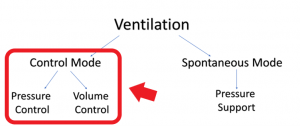Using Control Modes of Ventilation
When mechanical ventilation is indicated, it is normally because the patients are not oxygenating or ventilating appropriately. Indications for mechanical ventilation include: hypoxic failure, hypercapnia (or respiratory failure) and ineffective drive to breathe (See Chapter 2). When patients are acutely ill and experiencing indications for ventilation, their body cannot effectively balance their oxygenation or CO2 clearance needs without intervention. They are intubated and ventilated to take over control of these imbalances. A control mode of ventilation is the obvious choice, as there is a need to fully take over how much and how often the patient is breathing, since they are ineffective in fixing it on their own.
Key Takeaway
We have already discussed that there are two categories of control modes . One that is described via the volume of air delivered and one described by the pressure applied to the lungs (see Chapter 3). In this chapter, we will be narrowing our focus to the control mode branch of the ventilation “family tree:”

So, you have identified the need to control ventilate your patient, but now we have a choice to make: do we use pressure control or volume control? Which one is better?
We have discussed in Chapter 2 that both of these modes describe the exact same thing—air being pushed into the lungs. Realistically, once you understand the premise of these modes, you would be able to ventilate essentially the same in pressure or in volume by manipulating all of the settings on the ventilator. Though described in different ways, they are two sides of the same coin. Either pressure or volume, both control modes are simply a set amount of air being pushed in at a set rate.
This chapter will introduce both types of control modes, including differences and similarities. Though we cannot teach all of the subtleties of the parameter differences, at the end of this book, you should be able to comfortably set up volume control or pressure control to facilitate basic ventilation strategies for a patient.
Key Takeaways
Take a look at the following acronyms which are commonly used by practitioners when talking about volume control:
- A/C = assist/control (used to refer to control mode in general)
- PC or PCV = pressure control or pressure control ventilation
- VC or VCV = volume control or volume control ventilation
This might look a bit like “alphabet soup” to you, but don’t be anxious. Just translate these short-forms to control mode, pressure control or volume control, and you will understand perfectly. Over time, you will become more familiar with these acronyms and begin to use them yourself.
Media Attributions
- family_tree_control © Melody Bishop

